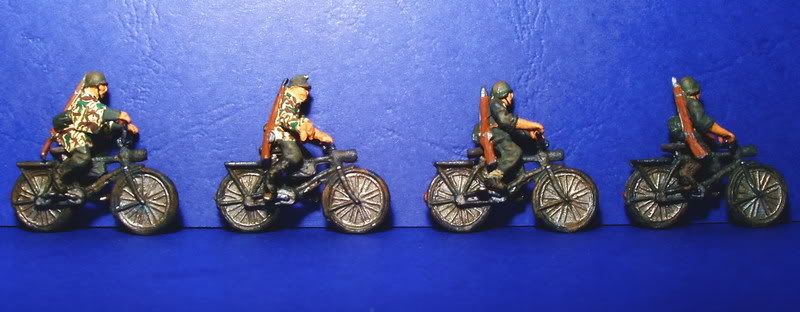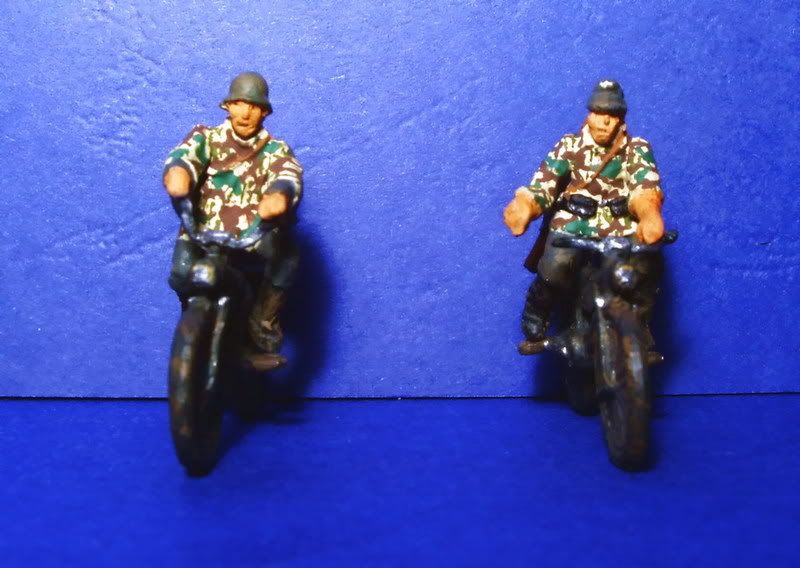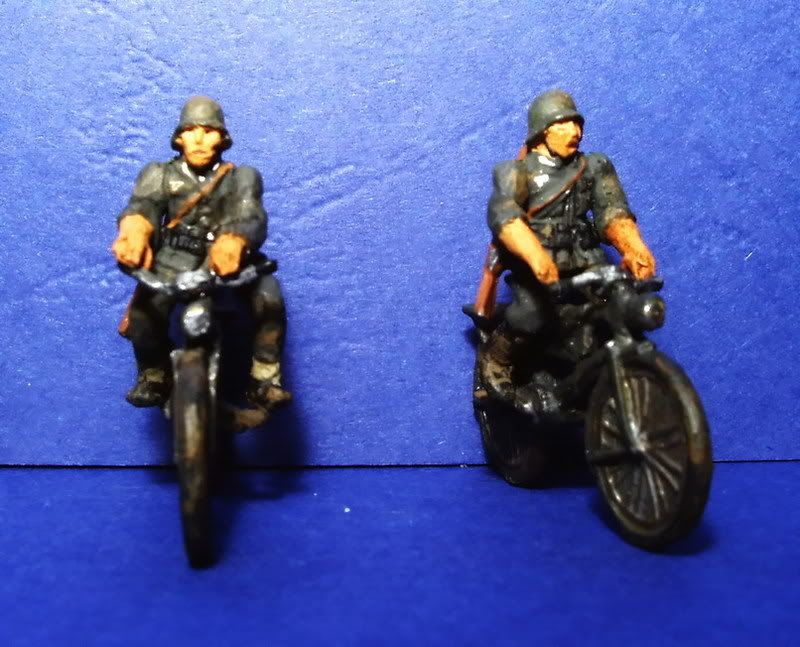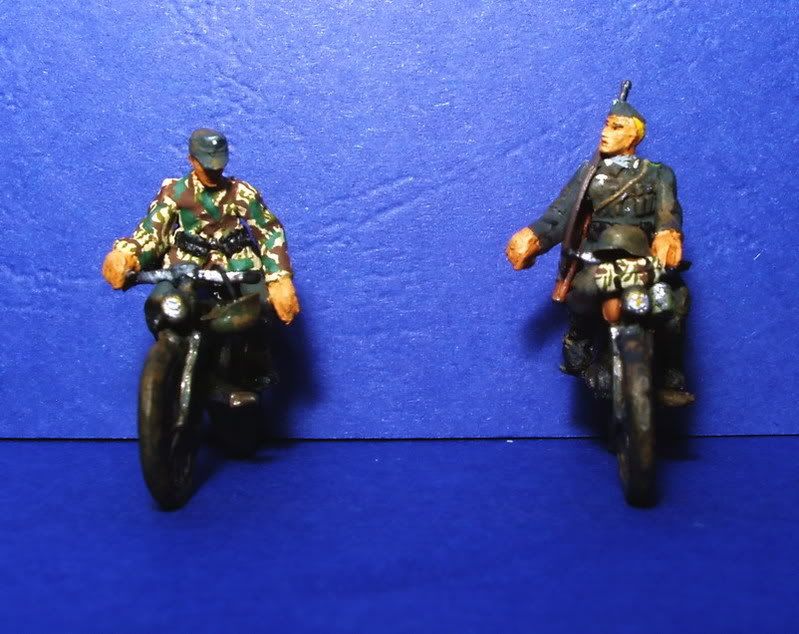This is HaT's German bicyclists set. The first five photos feature the "standard" four poses of the set while the other five show the same poses, but converted. I use for conversions Preiser heads, gear and weapons, Pegasus Hobbies weapons and the head with vegetation is from the present reviewed set (extra head). Also the bikes of the converted figures were endowed with equipment and weapons.
The soldiers wear Wehrmacht camouflage pattern.
Hope you enjoy the photos and the review. Comments/suggestions are very welcome.
Cristian Florescu
HaT 1/72
“WWII German Bicyclists”
| Manufacturer | HaT |
| Scale | 1/72 |
| Set Code | 8119 |
| Year | 2006 |
| No. of Figures | 12 |
| No. of Poses | 4 |
| Optional parts (no. of poses/total no. in the set) | 4 heads (12); 2 arms (6) |
| Other inclusions (no. of poses/total no. in the set) | 4 bicycles (12) |
| Aspect | Tall |
| Material | Soft Plastic |
| Optimal Period | 1939 -1945 |
Review
After two sets portraying German troops riding motorcycles, HaT has taken the great decision to develop the topic, aiming this time for other means of riding vehicles, also in twin sets, namely horses and bicycles, or in other words, one and zero h/p. The present review refers to the last one, an extremely used, but rarely met vehicle in this scale, the bicycle. Due to their cheap maintenance and advantages provided to soldiers, even the army who invented the Blitzkrieg, used such vehicles in large amounts. According to KStN, bicycles could be found in almost all the infantry companies, but also in Luftwaffe, Mountain and Artillery units, along all the stages of WWII. Many photos taken during the Battle of Berlin feature bicycles used not only by Volkssturm and Hitlerjugend, but also by regular army. Furthermore, it shouldn’t be considered odd to see a Panzer trooper riding a bicycle. Surely there were plenty of such cases, and it is still one of the most common vehicles ever invented. Likewise, sometimes the bicycles were looked upon as valuable replacements of the horses in cavalry units, and well appreciated for their value in reconnaissance missions.
In spite of their large usage, until the appearance of the present set, the existence in Braille scale soft plastic was almost symbolic, one of the most well-known example is the bicycle included in the 1/76 Airfix’s “German Mountain Troops”. Some other bicycles are included in diorama sets of the same producer, such as “Jungle Outpost” and “Forward Command Post”, but without German riders and again, in 1/76 scale. The collectors who actually crave after such items could find several in resin, a good representation being the CMK set related to the matter.
In order to better match the vehicles, the manufacturer adopted for the first time in a WWII German set, the solution of providing separate arms for the figures. Despite being produced in soft plastic, the material used is perfectly accepting super glue, which makes a durable bond, highly recommended being the gel one. The material looks like a combination between plastic and rubber. It’s not the same, but very similar with the one used by Pegasus Hobbies in their soft plastic sets or Dragon for the Mouse/E100 tank crews. Having separate arms, conversions are facilitated and to enhance this possibility, on the same sprue exist extra heads and a pair of arms.
The box includes three identical sprues, on each one there are four bicycles, four handle bars, four figures, ten arms and four extra heads. The artwork of the box is in the classical HaT style, featuring a soldier riding his bicycle.
With reference to the vehicles, a single quite accurate model is given, a nice touch being the StiHg-r 24 grenade case attached to the transversal frame. Together with a pump, they form the only equipment items on the bikes. The handle bar should be glued on its place and may be bent for better fitting the palms of the riders. In this scale, in bikes, a complicate issue is represented by the spokes. Two solutions have been until now adopted in soft plastic, namely full wheels with spokes graved on them, or the one of empty wheels where spokes are completely missing. Here it was chosen the first one. Corroborated with other factors, this creates the image of a robust vehicle, but it still remains a valuable and useful representation of a WWII German bike.
As it was stressed above, on each sprue there are four figures all in different poses or better said, all being unique, especially because of uniforms. It is a strange, but interesting thought to depict all the poses in a set in different types of uniforms. Nevertheless, this was facilitated by the small number of poses and the same approach was adopted by the company in the “sister” set related to cavalry.
One soldier is dressed in early war uniform, having M34 tunic, trousers and marching boots while the late war style is also present in a figure, through M43 tunic, trousers, ankle boots and gaiters. Parka is depicted in a soldier, who has also marching boots, and the last specific garment for a German soldier featured by the set is the Zeltbahn put over tunic. In spite of its intensive usage as camouflage or bad weather garment by soldiers on all the fronts along the entire period of WWII, Zeltbahns worn over uniforms are extremely rare in the scale, probably the best known being those from Revell’s “German Engineers” and “German Infantry” sets. Except the one dressed in parka who wears M43 cap, the rest of the figures have steel helmets, but heads may be replaced with the extra ones featured on the same sprue. There are four different heads, covered by M34 overseas cap, helmet with camouflage cover, steel helmet with camouflage vegetation and even a bare head.
Additionally to the extra heads, there are four arms with rolled, and four with long sleeves, as well as two arms for the trooper dressed in Zeltbahn. From a simple calculation, results that two arms are exceeding the necessary of bodies, and may serve for customization of any figure minus the one dressed in Zeltbahn.
The bicyclists may be enrolled both in Waffen SS or Wehrmacht troops, according to the specific camouflage patterns which the customer wants to reproduce. If the arms with rolled sleeves are not used, they can be used in all the seasons, the thickness of uniforms allowing such thing.
As it was normal when riding the bikes, the gear on these soldiers is quite simple, having just the appropriate ammo pouches, gas mask container and its strap. The figure with Zeltbahn is the only one who has no ammo pouches, but this is usual, in general the item being worn by soldiers over uniform and gear, so these can not be visible. On the back of each there is a Kar 98K.
All figures are sculpted in the riding act and fit pretty well the saddle, pedals and handle bars. For the hands to better hold the bars, it is recommended that before gluing the arms, to test the fit. Nevertheless, this component is from a very soft plastic, easy adjustable to meet the palms of the riders. Most pictures present this type of handle bar in a single form, but it can be assumed that even German soldiers accustomed it, like we did in our childhood. For this reason, I do not care too much about the pose of the handle bar. Furthermore, it is not very important for the figure to reach with both hands the handle bar, there are times when a rider holds it only with one hand, or even with none. The same issue is valid for legs, it has not a paramount importance for both of them to be on pedals.
We have here a very suitable set for conversions, the plastic used by HaT, in spite of being soft, gluing extremely well with the super glue gel. On the riders and vehicles may be glued various other items, made not only from soft or hard plastic, but also resin.
Except the conversions offered in the set through extra arms and heads, exist other options. For instance, as it was stressed above, these soldiers are pretty lightly equipped. If it is desired, mess tins, canteens, Zeltbahns, shovels, bayonets, bread bags etc, may be attached to the figures or to their bicycles. The Kar98K sculpted on the figures can be easily removed and replaced with other rifles. Moreover, due to the fact that the figure dressed in Zeltbahn has no ammo pouches, any weapon may be glued, MP40, StG44 or MP41 representing good choices which bring a plus of diversity to the set.
Considering once more the plastic that the set is made of, for extra gear and weapons, pieces from various sets by Preiser and Pegasus Hobbies are recommended. Most of the reference pictures from the period depict bicycles loaded with weapons and gear, so there is a lot of space for customization and variation according to the set owner’s decision and information materials.
In fact, it is normal for a soldier to have less on him and to put as many things as he can on the bike.
The accuracy of all the types of uniforms, and here there are a lot of them, is satisfactory and there can be seen buttons and shoulder boards on M34 and M43 tunics.
Concerning the anatomy, this is proper too, matching the size of most of 1/72 figures. Some of the faces are not the nicest in the scale, but who wants more expressive faces, may remove them and replace with Preiser heads for example.
No difference between the size of the weapons or gear in different poses is seen, and the flash is not impossible to be removed, even if it requires a little patience due the rubbery qualities of this plastic. The separate arms approach facilitated the absence of extra plastic, which is present in very low amounts at a couple of figures only at the connection of the helmet with the barrel.
The plastic used accepts perfectly any paint, and doesn’t confer a gloss aspect.
All the bicycles come with bases, but their removal is easy for those who do not want such things.
As mentioned, the compatibility of these figures with other offers on the market is very good. The types of uniform permit their usage in different periods of the war. The most useful stage of WWII is the last part, bearing in mind that the set offers a figure dressed in M43 tunic, and the M34 model was sent to troops until the end of the war. Nevertheless, the difference between them is very small, and in this scale it is not so obvious. Taking this into account, it is possible to employ them in the early war as well.
HaT’s “German Bicyclists” is on the one hand the only 1/72 representation in soft plastic of a charming subject, and on the other hand represents a reasonable continuation of the company’s series of WWII German riders.
Additionally, it shouldn’t be ignored that the set opens the door of the owner’s imagination for customizing, and their suitability for riding not only bicycles, but also motorcycles.
| Historical Accuracy | 9 |
| Anatomy | 8 |
| Poses Quality | 8 |
| Details Quality | 7 |
| Mould Quality | 8 |
| Sculpture | 7 |
| Recommendation/Utility | 9 |
| TOTAL | 8 |





CONVERSIONS




